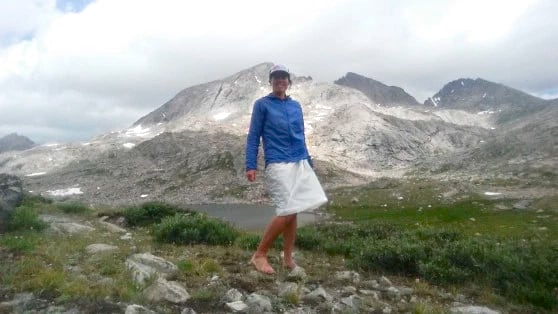Guest post by Renee Patrick
The fire spread in a blink of an eye and soon feathers were floating down around me like fat snowflakes. My down sleeping bag was the casualty in my momentary lapse of judgement that morning. I simply hadn’t let the alcohol dry on my hands when I lit my beer-can stove, and the moment my hand was on fire I waved it around (note: don’t do that) and splattered flames onto my sleeping bag.
It was day 100-something of my PCT thru-hike, and the only thing I could do was get out my patch kit of dental floss and a sewing needle to close up the 10 inch burn hole. Gathering as many feathers as I could, I stuffed them back in the gaping space that was once my sleeping bag and went to work.
You know what? That sleeping bag got me to Canada and I still have it. Its frankenstein mint-flavored patch job is still there. It still keeps me warm.
Don’t get me wrong, I love new gear. I have since purchased other sleeping bags. I have a -20 degree bag that was mandatory for the frigid nights during the two years I worked as a wilderness therapy staff in the deep winter of Central Oregon, I have a 40 degree quilt that I use for warmer summer nights when leading trail crews along the Oregon Desert Trail. There is a glut of cheap gear outlets, websites, and sales around the holidays, but I would love if we put more emphasis on reusing old gear, fixing our patches, zippers and waterproofing and making do with what we have.
Repair – Reuse – Recycle. We do it for cans, paper, glass. Let’s do it with our gear.
When I moved to Bend over a decade ago, I was stoked to see we had two used gear shops in town; I had outfitted myself entirely from used gear sales for my 2006 PCT thru-hike. Then I noticed a gear repair booth set up at various outdoor events. Even better! My thrifty nature was directly related to spending all of my money on long distance hikes, so along the way I looked for ways to get the most out of my gear and my dollars. Repair, reuse, recycle.
I first met Kim Kinney at a mutual friend’s art show. Kim was behind those gear repair booths I had been seeing, and she had the chops to fix almost any kind of outdoor gear. She had spent years working on custom gear design, and as an avid outdoors woman, she knows first hand what we put our gear through in the backcountry.
Kim has repaired several tents for me. I thought these would be intensive repair jobs; the zippers weren’t closing and seemed mangled, dirt and grime and years of backcountry use convinced me they needed to be replaced all together. It turned out to be quick and cheap and easy. New sliders on the zippers, was that it??
Before you throw out or donate that down coat with the burn hole, or that backpack with broken buckles, look into fixing it. I would imagine many mountain towns around the country have gear repair shops. Heck, even if you want to resell it on Craigslist, you will get more moolaa for it if it’s in good shape. Even if you break out the mint-flavored dental floss to sew up a tear, do it. Lets not throw more money down for things we don’t have to. Save it for that pizza and beer after hiking 100 miles through the Wind River Range, or after paddling a week in the Boundary Waters.
If you don’t have a gear repair shop near you, ship it to Kim. She works on a variety of gear, tents, backpacks and bags, motorcycle
clothing, luggage and zippers. Find out more here.
Repair – Reuse – Recycle
Lets make fixing our gear the first step before buying something new. Oh! And you don’t always have to have the fanciest gear… One of my favorite pieces of gear is a trash bag. It’s a rain skirt, pack cover, ground cloth, rain coat, stuff sack… You name it.

